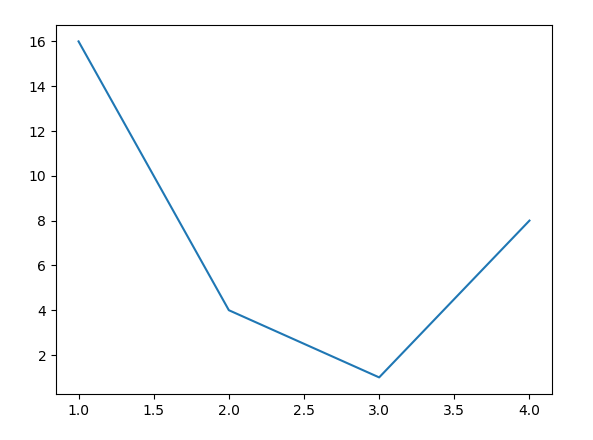Matplotlib.pyplot.twiny() in Python (original) (raw)
Last Updated : 11 Apr, 2020
Matplotlib is a library in Python and it is numerical – mathematical extension for NumPy library. Pyplot is a state-based interface to a Matplotlib module which provides a MATLAB-like interface.
Sample Code
import matplotlib.pyplot as plt
plt.plot([ 1 , 2 , 3 , 4 ], [ 16 , 4 , 1 , 8 ])
plt.show()
Output:
matplotlib.pyplot.twiny() Function
The twinx() function in pyplot module of matplotlib library is used to make and return a second axes that shares the y-axis.
Syntax:
matplotlib.pyplot.twiny(ax=None)
Parameters: This method does not accepts any parameters.
Returns: This returns the second axes that shares the x-axis
Below examples illustrate the matplotlib.pyplot.twiny() function in matplotlib.pyplot:
Example #1:
import matplotlib.pyplot as plt
import numpy as np
def GFG1(temp):
`` return ( 5. / 9. ) * (temp - 32 )
def GFG2(ax1):
`` y1, y2 = ax1.get_ylim()
`` ax_twin .set_ylim(GFG1(y1), GFG1(y2))
`` ax_twin .figure.canvas.draw()
fig, ax1 = plt.subplots()
ax_twin = ax1.twiny()
ax1.callbacks.connect( "ylim_changed" , GFG2)
ax1.plot(np.linspace( 10 , 120 , 100 ))
ax1.set_xlim( 0 , 40 )
ax1.set_xlabel( 'Fahrenheit' )
ax_twin .set_xlabel( 'Celsius' )
fig.suptitle('matplotlib.pyplot.twiny() function\
`` Example\n\n', fontweight = "bold" )
plt.show()
Output:
Example #2:
import numpy as np
import matplotlib.pyplot as plt
t = np.arange( 0.01 , 20.0 , 0.001 )
data1 = np.exp(t)
data2 = np.sin( 0.3 * np.pi * t)
fig, ax1 = plt.subplots()
color = 'tab:blue'
ax1.set_ylabel( 'time (s)' )
ax1.set_xlabel( 'exp' , color = color)
ax1.plot(data1, t, color = color)
ax1.tick_params(axis = 'x' , labelcolor = color)
ax2 = ax1.twiny()
color = 'tab:green'
ax2.set_xlabel( 'sin' , color = color)
ax2.plot(data2, t, color = color)
ax2.tick_params(axis = 'x' , labelcolor = color)
fig.suptitle('matplotlib.pyplot.twiny() function\
`` Example\n\n', fontweight = "bold" )
plt.show()
Output:
Similar Reads
- Matplotlib.pyplot.twinx() in Python Matplotlib is a library in Python and it is numerical - mathematical extension for NumPy library. Pyplot is a state-based interface to a Matplotlib module which provides a MATLAB-like interface. Sample Code # sample code import matplotlib.pyplot as plt plt.plot([1, 2, 3, 4], [16, 4, 1, 8]) plt.show( 2 min read
- Matplotlib.pyplot.sci() in Python Matplotlib is a library in Python and it is numerical - mathematical extension for NumPy library. Pyplot is a state-based interface to a Matplotlib module which provides a MATLAB-like interface. There are various plots which can be used in Pyplot are Line Plot, Contour, Histogram, Scatter, 3D Plot, 2 min read
- Matplotlib.pyplot.yticks() in Python Matplotlib is a library in Python and it is numerical - mathematical extension for NumPy library. Pyplot is a state-based interface to a Matplotlib module which provides a MATLAB-like interface. Matplotlib.pyplot.yticks() Function The annotate() function in pyplot module of matplotlib library is use 2 min read
- Matplotlib.pyplot.xticks() in Python matplotlib.pyplot.xticks() function is used to get or set the x-axis ticks in a plot. This function allows you to modify the labels and positions of the ticks along the x-axis, providing greater flexibility and control over your plots. Let's see an example to better understand this. Example: Set Cus 3 min read
- Matplotlib.pyplot.xlim() in Python Matplotlib is a library in Python and it is numerical - mathematical extension for NumPy library. Pyplot is a state-based interface to a Matplotlib module which provides a MATLAB-like interface. There are various plots which can be used in Pyplot are Line Plot, Contour, Histogram, Scatter, 3D Plot, 2 min read
- Matplotlib.pyplot.show() in Python Matplotlib is a library in Python and it is numerical - mathematical extension for NumPy library. Pyplot is a state-based interface to a Matplotlib module which provides a MATLAB-like interface. Sample Code - # sample code import matplotlib.pyplot as plt plt.plot([1, 2, 3, 4], [16, 4, 1, 8]) plt.sho 2 min read
- Matplotlib.pyplot.ylim() in Python Matplotlib is a library in Python and it is numerical - mathematical extension for NumPy library. Pyplot is a state-based interface to a Matplotlib module which provides a MATLAB-like interface. matplotlib.pyplot.ylim() Function The ylim() function in pyplot module of matplotlib library is used to g 2 min read
- Matplotlib.pyplot.triplot() in python Matplotlib is a library in Python and it is numerical - mathematical extension for NumPy library. Pyplot is a state-based interface to a Matplotlib module which provides a MATLAB-like interface. There are various plots which can be used in Pyplot are Line Plot, Contour, Histogram, Scatter, 3D Plot, 2 min read
- Matplotlib.pyplot.sca() in Python Matplotlib is a library in Python and it is numerical – mathematical extension for NumPy library. Pyplot is a state-based interface to a Matplotlib module which provides a MATLAB-like interface. There are various plots which can be used in Pyplot are Line Plot, Contour, Histogram, Scatter, 3D Plot, 1 min read
- Matplotlib.pyplot.quiver() in Python Matplotlib is a library of Python bindings which provides the user with a MATLAB-like plotting framework. Matplotlib can be used in Python scripts, the Python and IPython shell, web application servers, and various graphical user interface toolkits like Tkinter, awxPython, etc. Matplotlib.pyplot.qui 2 min read